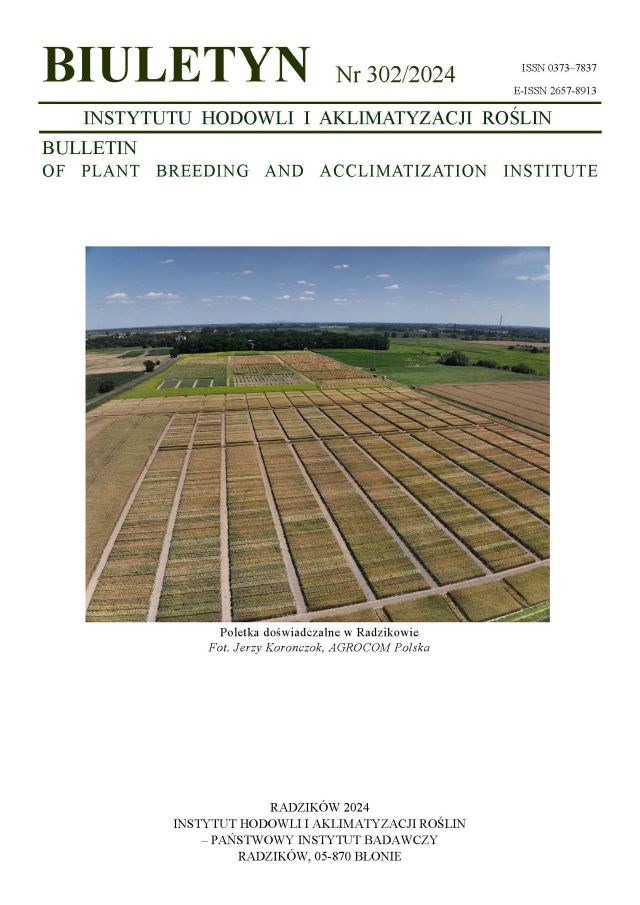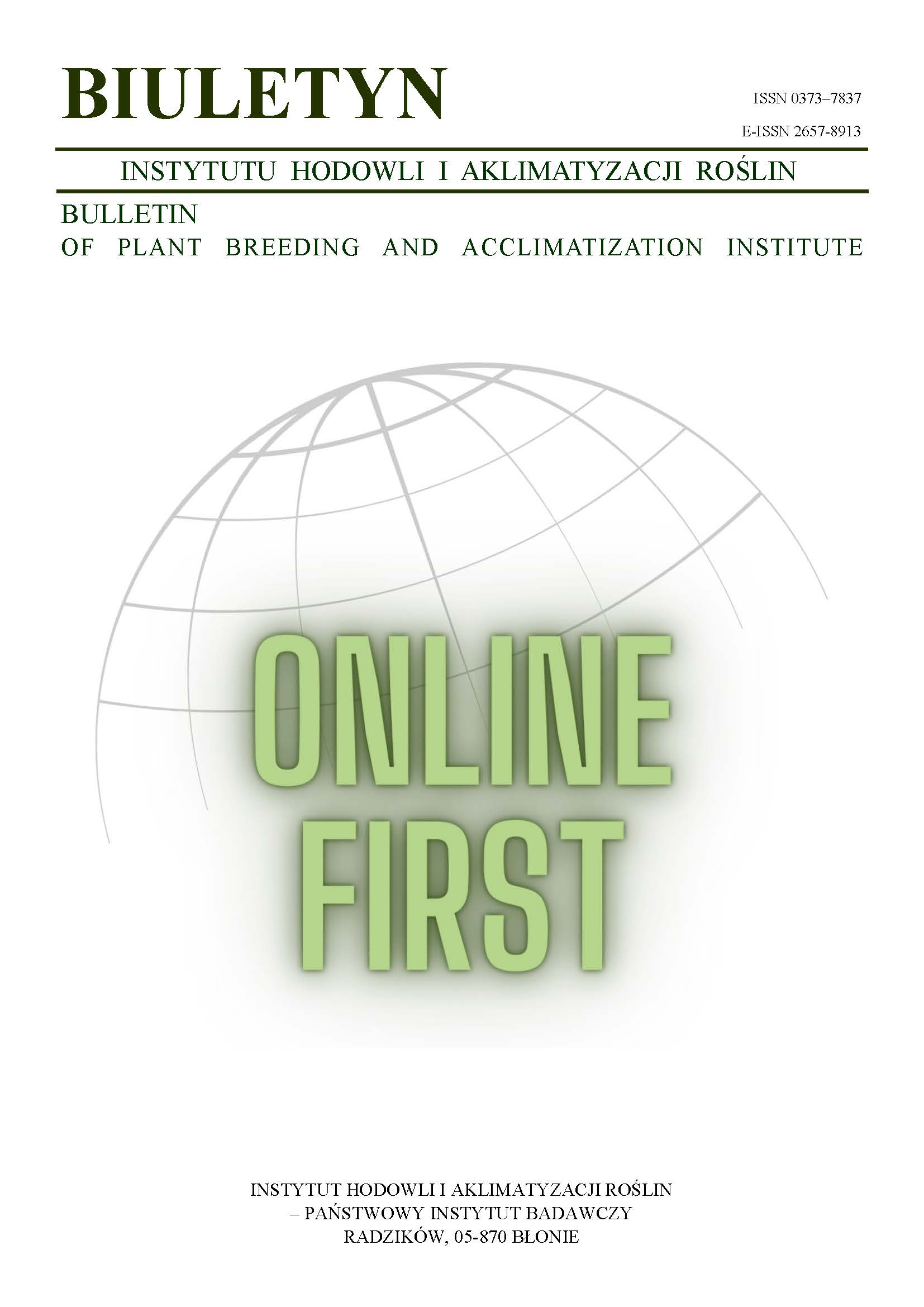Estimation of breeding suitability of hybrids of rye (Secale cereale L.) with wild species from the genus Secale
Danuta Mackiewicz
agro@up.poznan.plKatedra Genetyki i Hodowli Roślin, Akademia Rolnicza w Poznaniu (Poland)
Zbigniew Broda
Katedra Genetyki i Hodowli Roślin, Akademia Rolnicza w Poznaniu (Poland)
Abstract
The investigations on interspecific hybrids of rye cultivars and wild species S. montanum, S. kuprijanovii, S. sylvestre and S. vavilovii, have been conducted for many years. The aim of these studies was the extension of variability of the initial plant material for rye breeding. The problem, which is often encountered in the forms obtained by interspecies crossing, is the crop and its quality. The intraspecific hybrids in species Secale cereale L. and interspecific hybrids of S.c. ssp. cereale with the Secale strictum ssp. africanum have not been used so far. The sib F2 generation of the reciprocal, intraspecific hybrids of Secale cereale L. ssp. cereale (cultivars) with the wild S.c. ssp. afghanicum, S.c. ssp. ancestrale and S.c. ssp. segetale and interspecific hybrids of S.c. ssp. cereale with the Secale strictum ssp. africanum were used in this study. Some of the tested hybrids possess a number of valuable traits. From the hybrids of rye cultivars with S.c. ssp. afghanicum and S.c. ssp. ancestrale, plants resistant to powdery mildew and brown rust were selected. Moreover, the selected resistant plants had long ears and the grain weight per ear was comparable to that in cultivated rye varieties. Selected hybrids with short straw and long ears can be used to breed the short straw varieties. Because of very broad leaves, the interspecific hybrids of S.c. ssp. cereale and Secale strictum ssp. africanum can be utilized as parental forms in breeding of rye pasture varieties. The results show that the tested hybrids can be very useful in rye breeding as an initial plant material.
Keywords:
Secale, genetic resources, hybrid breeding, interspecific hybrids, ryeReferences
Hammer K., E Skolimowska, H. Knüpffer 1987. Vorarbeiten zur monographischen Darstellung von Wildpflanzensortimenten: Secale L. Kulturpflanze 35: 135 — 177.
DOI: https://doi.org/10.1007/BF02113274
Google Scholar
Kobyljanskij V. D. 1982. Roż. Kołos, Moskwa: 137 — 152.
Google Scholar
Kobyljanskij V. D. 1987. Studies of rye and their relations to aspects of breeding. Vestn. Selsch. 111: 35 — 41 (Wheat, Barley and Triticale Abstr. 1988, 5: poz. 3827).
Google Scholar
Koczowska I. 1977. Badania nad otrzymywaniem materiałów wyjściowych żyta ozimego do hodowli odmian plennych odpornych na wyleganie i pleśń śniegową. Zesz. Nauk. ART w Olsztynie, 19: 49 — 74.
Google Scholar
Kranz A. R. 1961. Cytologische Untersuchungen und Genetische Beobachtungen zum Beischpiel zwieschen Secale cereale L. und Secale kuprijanovii. Züchter. 31: 219 — 225.
DOI: https://doi.org/10.1007/BF00709537
Google Scholar
Kuckuck H., Peters R. 1970. Weitere genetisch-züchtensche Untersuchungen, an Secale vavilovii Grossh. Z. Pflanzenzücht. 64: 182 — 200.
Google Scholar
Lehmann C., Plarre W. 1982. Untersuchungen zur Bildung quantitativer Markmale in Kreuzungpopulation Secale cereale × Secale silvestre nach Rückkreuzung mit der Kulturform. Tag. — Ber. Akad. Landwirsch. — Wiss. DDR. Berlin, 198: 79 — 90.
Google Scholar
Łapiński M. 1975. Cytoplasmic male sterility in interspecific rye hybrids. Hod. Rośl. Aklim. 19 (5/ 6): 415 — 420.
Google Scholar
Łapiński M. 1977. Wstępne wyniki badań nad krzyżówkami oddalonymi w rodzaju Secale. Pr. Zesp. Hod. Żyta w 1975 r. IHAR Radzików: 89 — 95.
Google Scholar
Nűrnberg-Krűger U. 1960. Zytologischen Untersuchenden an der Gattung Secale L. Z. Pflanzenzűcht. 44: 65 — 72.
Google Scholar
Rozmus M. 1967. Badania cytoembriologiczne nad gatunkami rodzicielskimi oraz mieszańcami Secale cereale L. × S. montanum Guss. i S. cereale L. × S. vavilovii Grossh. form di- i tetraploidalnych. Hod. Rośl. Aklim. 11 (4): 409 — 453.
Google Scholar
Ruebenbauer T. 1975. Podstawowe problemy genetyki zbóż. Post. Nauk Rol. 2: 3 — 4.
Google Scholar
Rzepka D. 1988. Właściwości międzygatunkowych mieszańców żyta (Secale sp.). Hod. Rośl. Aklim. 32
Google Scholar
(3/ 4): 27 — 38.
Google Scholar
Rzepka D. 1993. Badania nad mieszańcami S. cereale × S. vavilovii Gross. w aspekcie ich przydatności w hodowli odmian żyta odpornych na porastanie. Część I Ocena odporności na porastanie mieszańców międzygatunkowych żyta. Hod. Rośl. Aklim. 37 (5/ 6): 69 — 79.
Google Scholar
Rzepka D. Łapiński M. 1988. Przydatność międzygatunkowych mieszańców żyta (Secale sp.) w hodowli odmian odpornych na mączniaka (Erysiphe graminis DC. f. sp. secaliss Marchal). Hod. Rośł. Aklim. 32, 3/ 4: 39 — 48.
Google Scholar
Rzepka D., Tomczak P. 1984. Ocena cech użytkowych mieszańców międzygatunkowych żyta i ich przydatność w hodowli nowych odmian. Zesz. Nauk. AR Szczecin, 115: 179 — 189.
Google Scholar
Rzepka D., Tomczak P. 1993. Badania nad mieszańcami S. cereale × S. vavilovii Gross. w aspekcie ich przydatności w hodowli odmian żyta odpornych na porastanie. Część II. Właściwości użytkowe mieszańców. Hod. Rośl. Aklim. 37 (5/6): 81 — 91.
Google Scholar
Rzepka-Plevneš D., Tomczak P., Pławska M. 1995. Możliwość wykorzystania mieszańców międzygatunkowych żyta w hodowli odmian plennych i odpornych na mączniaka prawdziwego (Erysiphe graminis DC. f. sp. secalis Marchal). Hod. Rośl. Aklim. 39 (6): 68 — 80.
Google Scholar
Singh R. 1977. Cross compatibility, meiotic pairing and fertility in 5 Secale species and their interspecific hybrids. Cereal Res. Commun. 5 (1): 67 — 75.
Google Scholar
Słaboński A., Rzepka D., Pieniążek B. 1984. Możliwość wykorzystania mieszańców międzygatunkowych Secale cereale × S. montanum, S. cereale × S. kuprijanovii, S. cereale × S. vavilovii w hodowli żyta. Hod. Rośl. Aklim. 28 (2): 195 — 208.
Google Scholar
Sołoduchina O. 1982. Donorskie sposobnosti istoćnikov ustojćivosti rżi k buroj rżavćine. Trudy po Prikl. Bot. Genet. i Selekcii. VNJJ. Rastenevod, 73 (1): 61 — 65.
DOI: https://doi.org/10.1007/BF00291339
Google Scholar
Szigat G., Nürnberg U. 1982. Möglichkeiten zur Nutzung von Secale silvestre Bastarden als Ausgangmaterial für die Züchtung. Tag. — Ber. Akad. Landwirtsch. —Wiss. DDR Berlin. 198: 73 — 78.
Google Scholar
Tarkowski Cz. 1983. Biologia żyta, PWN, Warszawa.
Google Scholar
Węgrzyn S. 1988. Synteza i wyodrębnianie materiałów wyjściowych dla hodowli zbóż. Zesz. Probl. IHAR Radzików: 33 — 40.
Google Scholar
Authors
Danuta Mackiewiczagro@up.poznan.pl
Katedra Genetyki i Hodowli Roślin, Akademia Rolnicza w Poznaniu Poland
Authors
Zbigniew BrodaKatedra Genetyki i Hodowli Roślin, Akademia Rolnicza w Poznaniu Poland
Statistics
Abstract views: 65PDF downloads: 22
License
Copyright (c) 2004 Danuta Mackiewicz, Zbigniew Broda

This work is licensed under a Creative Commons Attribution-ShareAlike 4.0 International License.
Upon submitting the article, the Authors grant the Publisher a non-exclusive and free license to use the article for an indefinite period of time throughout the world in the following fields of use:
- Production and reproduction of copies of the article using a specific technique, including printing and digital technology.
- Placing on the market, lending or renting the original or copies of the article.
- Public performance, exhibition, display, reproduction, broadcasting and re-broadcasting, as well as making the article publicly available in such a way that everyone can access it at a place and time of their choice.
- Including the article in a collective work.
- Uploading an article in electronic form to electronic platforms or otherwise introducing an article in electronic form to the Internet or other network.
- Dissemination of the article in electronic form on the Internet or other network, in collective work as well as independently.
- Making the article available in an electronic version in such a way that everyone can access it at a place and time of their choice, in particular via the Internet.
Authors by sending a request for publication:
- They consent to the publication of the article in the journal,
- They agree to give the publication a DOI (Digital Object Identifier),
- They undertake to comply with the publishing house's code of ethics in accordance with the guidelines of the Committee on Publication Ethics (COPE), (http://ihar.edu.pl/biblioteka_i_wydawnictwa.php),
- They consent to the articles being made available in electronic form under the CC BY-SA 4.0 license, in open access,
- They agree to send article metadata to commercial and non-commercial journal indexing databases.
Most read articles by the same author(s)
- Sylwia Mikołajczyk, Dorota Weigt, Agnieszka Tomkowiak, Zbigniew Broda, Jan Bocianowski, Haploidization of the rye — the molecular diagnostics and the influence of nanomolecules on supporting the induction and regeneration of plants in in vitro conditions , Bulletin of Plant Breeding and Acclimatization Institute: No. 286 (2019): Special issue
- Anna Ćwiklińska, Zbigniew Broda, Jan Bocianowski, Comparative analysis of the features of wild species within the genus Secale for widening genetic variability to be utilized in breeding , Bulletin of Plant Breeding and Acclimatization Institute: No. 252 (2009): Regular issue
- Zbigniew Broda, Agnieszka Tomkowiak, Krzysztof Moliński, Józef Adamaczyk, The evaluation of genetic similarity between parental components of maize hybrids by means of molecular markers AFLP and RAPD , Bulletin of Plant Breeding and Acclimatization Institute: No. 244 (2007): Regular issue
- Zbigniew Broda, Agnieszka Dobrzycka, Jan Bocianowski, Genetic similarity of various populations of alfalfa (Medicago sativa L. sl.) and their seed yield potential , Bulletin of Plant Breeding and Acclimatization Institute: No. 252 (2009): Regular issue
- Anna Ćwiklińska, Zbigniew Broda, Danuta Kurasiak-Popowska, Differentiation of flowering biology among species of rye in the genus Secale , Bulletin of Plant Breeding and Acclimatization Institute: No. 251 (2009): Regular issue
- Zbigniew Broda, Danuta Kurasiak-Popowska, Aleksandra Kowalska, Anna Ćwiklińska, The analysis of genetic similarity among Secale species , Bulletin of Plant Breeding and Acclimatization Institute: No. 247 (2008): Regular issue
- Zbigniew Broda, Agnieszka Dobrzycka, The study of self-incompatibility and genetic similarity of genetically differentiated forms of alfalfa (Medicago sativa L.) , Bulletin of Plant Breeding and Acclimatization Institute: No. 245 (2007): Regular issue
- Zbigniew Broda, Agnieszka Tomkowiak, Danuta Mackiewicz, Anita Dobek, Henryk Woś, Janina Woś, Roman Warzecha, Krystyna Warzecha, Molecular marker based study of genetic diversity of triticale lines suitable for hybrid breeding , Bulletin of Plant Breeding and Acclimatization Institute: No. 237/238 (2005): Regular issue
- Agnieszka Tomkowiak, Zbigniew Broda, Krzysztof Moliński, A choice of the mathematical model for the relationship between heterosis effect of F1 hybrids and genetic distance of rye and triticale parental lines , Bulletin of Plant Breeding and Acclimatization Institute: No. 250 (2008): Regular issue
- Agnieszka Katańska, Zbigniew Broda, The influence of 2.4 D and picloram on androgenesis of winter triticale (Triticosecale Wittm.) , Bulletin of Plant Breeding and Acclimatization Institute: No. 237/238 (2005): Regular issue














